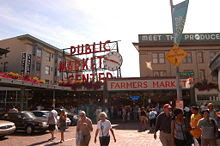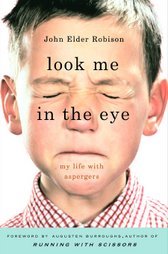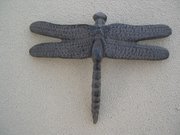
By the 1940s, more than two-thirds of the stalls in Pike Place Market were owned by Japanese-Americans. Following the bombing of Pearl Harbor December 7, 1941, President Roosevelt signed Executive Order 9066 February 19, 1942, which forced all Americans of Japanese ancestry in the "exclusion zone" of western Washington, western Oregon, California, and southern Arizona into internment camps in California. Their property, including any stalls at Pike Place, was confiscated and sold.
In 1963, a proposal was floated to demolish Pike Place Market and replace it with Pike Plaza, which would include a hotel, an apartment building, four office buildings, a hockey arena, and a parking garage. However, there was significant community opposition and an initiative was passed on November 2, 1971 that created a historic preservation zone and returned the Market to public hands. The Pike Place Market Preservation and Development Authority was created by the city to run the Market. Over the course of the 1970s, all the Market's historic buildings were restored and renovated using the original plans and blueprints and appropriate materials.

In the 1980s, federal welfare reform squeezed the social services based in the Market. As a result, a nonprofit group, the Pike Place Market Foundation, was established by the PDA to raise funds and administer the Market's free clinic, senior center, low-income housing, and childcare center. Also in the 1980s the wooden floors on the top arcade were replaced with tiles (so as to prevent water damage to merchandise on the lower floors) that were laid by the PDA after staging a hugely successful capital campaign - people could pay $35 to have their name(s) inscribed on a tile. Between 1985 and 1987, more than 45,000 tiles were installed and nearly 1.6 million dollars was raised.
Currently, the longest tenured vendor at the Pike Place Market is Sol Amon's Pure Food Fish. Inheriting the business from his father, Sol has donned his apron at Pure Food Fish for over fifty years. Sol's presence can often be seen outside his stall chatting with visitors and helping them choose the best fish to bring home to their families. He helps them package his special Alderwood Smoked Salmon or Copper River Salmon to enjoy in their homes after their trip.
One of the Market's major attractions is Pike Place Fish Market, where employees throw three-foot salmon and other fish to each other rather than passing them by hand. When a customer orders a fish, an employee at the Fish Market's ice-covered fish table picks up the fish and hurls it over the countertop, where another employee catches it and preps it for sale.

According to the employees, this tradition started when the fishmongers got tired of having to walk out to the Market's fish table to retrieve a salmon each time someone ordered one. Eventually, the owner realized it was easier to station an employee at the table, to throw the fish over the counter. The "flying fish" have appeared in an episode of the television sitcom Frasier that was shot on location and have been featured on The Learning Channel and was also in the opening credits of MTV's The Real World: Seattle.

Starbucks Coffee was founded near Pike Place Market in 1971. The three partners were inspired to open the store and sell high-quality coffee beans. The first store relocated to Pike Place Market in 1976, where it is still in operation. The sign outside this branch, unlike others, features the original logo - a bare-breasted siren that was modeled after a 15th century Norse woodcut. It also features a large pig statue, a landmark throughout the market.

Pike Place Market's official mascot, Rachel, a bronze cast piggy bank that weighs nearly 600 pounds, is located at the corner of Pike Place under the "Public Market Center" sign. Rachel was designed by local artist Georgia Gerber and modeled after a pig (also named Rachel) that lived on Whidbey Island and was the 1977 Island County prize-winner. Rachel receives roughly $9,000 annually in just about every type of world currency, which is collected by the Market Foundation to fund the Market's social services. Locals make a habit of emptying their pockets and rubbing Rachel's snout for good luck.
My Town Monday is the brilliant conception of Travis Erwin. Please visit his blog for links to other fabulous places.










15 comments:
Fascinating history. I want some of that salmon. My best friend at work is headed to Seattle in a few weeks. I'll tell him to bring me some back.
Travis,
They'll ship it to you and it's fresh and yummy!
I was there two years ago and loved that area. Thanks for reminding me.
I am a history buff and I love all the history in this post.
Terrie
I hate history, but I loved that post. It made me want to vacation in Seattle and see fish thrown about. Very cool.
I'm so glad the preservationists won and the market was saved. Thanks for an interesting post.
I'm with Robin, except I want to rub the pig snout too.
What a fascinating place! I love markets full of hustle and bustle, different smells and sounds - great !
I love history like this. And that salmon, too...Friends of ours used to send us packs of smoked salmon from Seattle and we relished it!
Were the Japanese-Americans who lost their stalls able to claim them back or buy them back after the war? What a hateful rip off; the same thing happened in California and families lost everything they had worked so hard for -- farmland that they had made productive by sheer ingenuity was taken away from them and snapped up by greedy neighbors. It is so sad.
I go to the Pike Place Market whenever I'm in Seattle- I love it there. I especially remember during the hippy hey day where it was filled with incense and candle makers etc... and gotta love the pig...
we loved this market. what truly amazed us were the flowers! so many huge bouquets of gorgeous flowers that were so cheap! we were floored. (we visited over labor day weekend in 2004.) thanks for a great post, AW!
I came over here from Jason's blog and found this really fascinating. I'm so naive because I'm truly surprised at all the bullshit happening in government, past and present!
You're just trying to make me regret even more I didn't make it to Seattle, aren't you?
(I wanted to, really I did. Instead, they sent me to Phoenix - in June. What did I ever do to them?)
Wow! I am impressed with all that knowledge and history you have!
Just wanted to stop by and say hi and thank you so much for your encoraging words on Jason's blog abotu my story GPS.
BTW I also commented on your Father's Day Sucks posting. troubled father/daughter relationships make for difficult lives (I had one too) but great heartfelt books. Look at all the material and emotion you have for your stories now...
What a great post! I want to go to this market!
Post a Comment